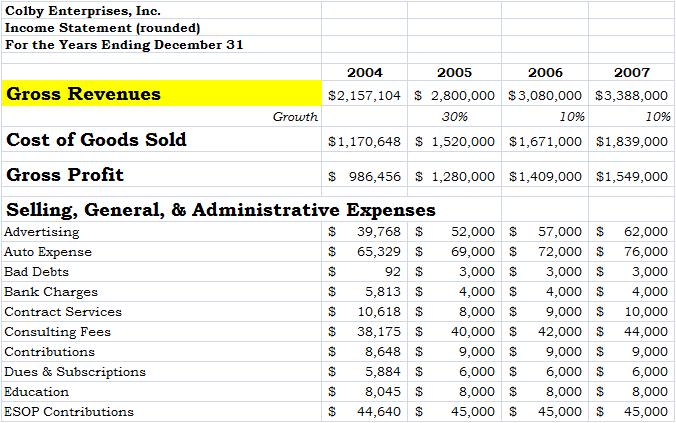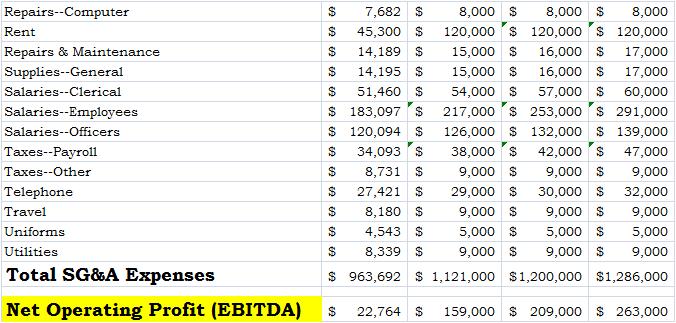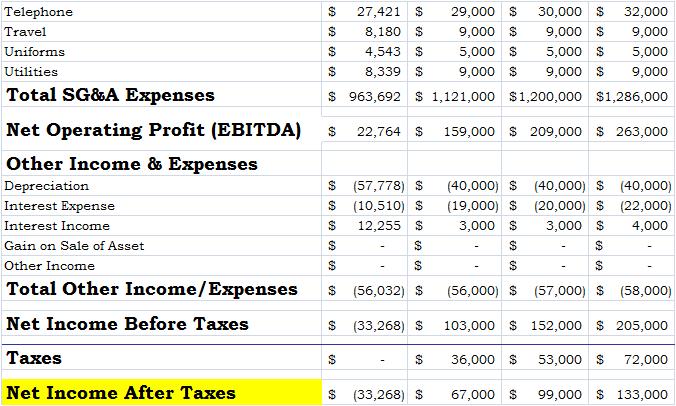If you are starting a business, presumably you are doing so to make a Profit. Therefore, it is a cardinal sin to start a business to make a Profit, if you don’t in fact understand exactly what Profit is. Here we will walk through the basics of the Income Statement, which is the most fundamental of the several financial statements all businesses need to prepare and understand. Without understanding the Income Statement, it is not possible to fully understand what Profitability is.
The Income Statement has three basic elements: Sales (or Revenues), Expenses (or Costs), and Profit. In fact, Profit is just Revenues minus Expenses. So in a scenario where you start a business that has $100 in Revenues and $60 in Expenses, the Profit would be $100 – $60 = $40. This is a very simple example, but it gives you an idea of the basic elements of the Income Statement and how to determine the level of Profits.
The first element of concern is Revenues. As you can see in the example below, there is a reason that Revenues are often referred to as the “top line,” as they are literally the first line on the Income Statement.
As can be seen above, the next item on the Income Statement, after Revenues, is typically Cost of Goods Sold or Cost of Sales. These costs include all direct costs involved with providing or manufacturing the service(s) or product(s) that are generating your Revenues.
Once you subtract the Cost of Goods Sold (or Cost of Sales) from the Revenues, you arrive at Gross Profit. You may have heard the term Gross Profit Margin before, which is typically expressed as a percentage. So, in the example above, in 2007, the company generated $3,388,000 in Revenues and had Costs of Goods Sold of $1,839,000, which led to a Gross Profit of $1,549,000. This is a Gross Profit Margin of $1,549,000/$3,388,000, or 46%.
The following category of Expenses that must be considered is Selling, General and Administrative (S,G, &A) expenses. These are the Operating Expenses that allow you to sell your products/services and administer the business. As you can see above and below, SG&A Expenses often include such things as Advertising, Rent, and Utilities, among other costs that tend to be relatively fixed in nature – that is, they are costs that don’t vary directly with the level of Revenues.
Once the SG&A Expenses are subtracted from the Gross Profit, you arrive at the next level of Profit, which is typically called Operating Profit. You’ll also often hear it referred to a as EBITDA (“ee-bit-dah”), which stands for earnings before interest, taxes, depreciation and amortization. Don’t get hung up on all of these terms at this point, but just realize that when you hear someone talking about “ee-bit-dah”, they’re referring to Operating Profit.
In the following graphic, you will see that as you move further down the Income Statement, the next category of items to consider is referred to as Other Income and Expenses. This includes such items as Depreciation, Interest, and other non-SG & A or non-typical Revenue items, such as the gain on the sale of assets.
Once Other Income and Expenses are subtracted from, or added to the Net Operating Profit, whichever the case may be, you arrive at Net Income Before Taxes. Once Taxes are then subtracted from this amount, you arrive at Net Income After Taxes, which you’ll often hear referred to as the “bottom line” and now you can see why – it’s the last item on the Income Statement.
The example use above is simplified, of course. There are many nuances to understanding the Income Statement and financial performance in great depth. However, although simplified, the above example does give you the basics of what you need to know about how an Income Statement is structured, what the common important elements are, and how to arrive at and understand the Profits (or Income) of the business.






Not understanding the financial position of your business is anathema. How can a business be profitable if it doesn’t know if it is making a profit?
Thanks for your comment. Agreed. It’s extremely important to understand the financial position of your company, yet many entrepreneurs, particularly those who don’t like numbers, tend not to want to spend much time thinking about it. It is possible to be profitable without knowing you’re making a profit, of course, but it’s very tough to make informed top-line and expense-related decisions without a solid understanding of your company’s financial position.
Can you please post the list of SG&A expenses? The list jumps from ESOP Contributions to Repairs – Computers. As someone trying to project a startups potential expense pitfalls, I’d kindly appreciate the considerations to keep in mind. Thanks!
Carlos, please see the email I sent you a few days back. Paul
Paul,
I am starting a new business and am looking for the best way to do the three main financial statements for a start-up, Cash Flow, Income Statement and Balance Sheet. Should the SG&A items be separate from the COG? If so is there a general accounting list I can find somewhere?
Thanks
Brian Endicott
Brian, unless you have some background in accounting, it will be hard for you to link the income statement, balance sheet and cash flow statement together. If you’re determined, you’ll be able to figure it out, but it won’t be too straightforward without some basic financial and accounting knowledge. An alternative would be to use a software such as Business Plan Pro, or something similar. Such software allows you to enter your assumptions, then it will generate the financial statements. I’m not a huge fan of having financials look like a “black box” to the entrepreneur, but depending on your situation and time pressure, it may be a good place to start. Also, I believe that many such software programs allow you to export the financials to Excel, so you can play with them there and gain a better understanding of how the pieces fit together. Yes, SG&A is separate and distinct from COGS. I would pick up a basic accounting text book, or a business plan guide, which will give you some more explanation of the differences between the various elements of the financial statements. Such a book should also give you a list of the various components of each financial statement.
Greetings Paul,
I am desireous of starting a small sandwich and salad shop. I cannot seem to find the requisite information germane to my business-type, which has a plethora of customer offerings. How do I create a break-even or (CVP/EVP) analysis for a business that is NOT running yet? How do I create break-evens for each sandwich and each salad. I need to know how much to charge, and do not desire to create prices that mirror my competitors because it could make my business unprofitable from the start. I have fixed costs (rent, insurance, fees, loans, phone etc), but it’s the variable costs that are confusing for this type of business. Do I look at each slice of bread, meats, condiments, utilities that are used in the creation process, inventory etc? I’m really confused at this juncture. Kindly share for me a sense of direction so that I can create my business specific break-even and profitability analyses.
Thanks Much,
Rob
Paul, I am preparing the financial files for a start up and I have a question: where do the investment we project to receive in the next rounds goes? cash flow? income statement? and where exactly? I mean, it’s not a revenue but it’s certainly part of the equation.
cheers,
juan
For anyone else who lands on this post, Microsoft has a great excel pre-made income statement template here: https://office.microsoft.com/en-us/templates/income-statement-TC001074461.aspx
Re:The Article – The most important thing I learned when starting out on my own was that the data is everything. You need to know exactly where every dime goes, how it’s used, and what it brings back (in terms of rev/exp)
I swear, 80% of the job is just optimizing what’s already going on. Good luck guys!
Michael